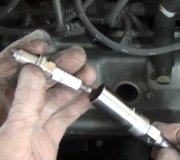Can you actually feel the misfire or are you just going by the fault code? Engine Computers are pretty good at detecting misfires that are too subtle for us to feel. Either way, it has to be related to fuel, compression, spark, or timing. We know it's not timing because all the other cylinders are okay. Low compression will cause a low power pulse. Even though it's not really a misfire, it's the slowdown in crankshaft speed that the computer detects. Those are the misfires you often don't feel.
Your injector test is valid but it only tells us it is capable of flowing fuel, not how much. GM has a real big problem with hard-to-pinpoint misfires due to injectors with unequal flow rates. They just grab a handful of them on the assembly line and throw them in with no regard to flow-matching. They get away with that at first, but at higher mileages the fault codes start to show up. The solution is a set of rebuilt and matched injectors. Chrysler buys their injectors from Bosch in flow-matched sets so they don't have that problem. Those are the only two manufacturers I can remember the story about. This comes from Jim Linder out of Indianapolis. His company rebuilds injectors, and he puts on very high-level classes for large groups of mechanics. I was lucky that he put on a one-day class at my school a number of years ago, in Wisconsin, for about 50 people. You can do a search for him and read all about the common things injectors cause.
In your case simply knowing the injector isn't plugged isn't enough. While it appears Ford doesn't have much trouble with theirs, you might consider switching two injectors, then erase the fault code and see if it sets again for the other cylinder. If the code is still for cylinder six, we can rule that out.
I'm not ready to think about a vacuum leak that affects just one cylinder. It would be different if you had a carburetor because air sneaking in through a leak would not draw the right amount of fuel into the cylinder. That's not the case though with fuel injection. The injector is going to spray the right amount of fuel regardless of where the air comes from. You would get a lean fault code for the side of the engine with the leak. The computer wouldn't know which cylinder is responsible so it would just try to add fuel to all three cylinders on that side. You'd see real high positive short term fuel trim numbers.
If you haven't already, consider doing a compression test, especially if you don't really feel the misfire. A power balance test is a good idea too. On older cars we just disabled one cylinder at a time by shorting a spark plug wire, and watching how much the engine speed dropped. Now everything has some type of automatic idle speed so we can't go by that. The unit on Chryslers is so effective, you can disable six cylinders on a V-8 engine and it will still maintain the correct idle speed. On a scanner you would read the number of "steps" the computer has placed the idle speed motor at. Ford does it differently than everyone else. They apply a variable voltage to a spring-loaded solenoid To do the balance test you'd disable one cylinder, then watch how much the voltage to the solenoid, or the percent of valve opening increases. Some scanners display both values, and some display only one. If you find that cylinder six isn't producing as much power as the others, and everything else seems okay, think about a broken rocker arm, worn push rod, or worn lobe on the camshaft.
Tuesday, June 17th, 2014 AT 9:51 PM


